Hybrid Coils-Based Wireless Power Transfer for Intelligent Sensors
Abstract
1. Introduction
- Designed and implemented of an MRC prototype to supply adequate power to a medical or sensor device system consisting of a wearable heart rate sensor, Arduino Nano microcontroller, and an nRF24L01 wireless protocol module.
- Hybrid topologies between spider and spiral coils were investigated in terms of transfer power, efficiency, and distance.
- Used these coils to transfer power from the transmitter coil to the receiver coil for operating the measurement unit then sends the measurement data to the monitoring unit by using a wireless protocol.
- Compared current study with previous studies according to the hybrid topology of coils in terms of transfer power, efficiency, and distance between transmitter and receiver.
2. Related Work
3. System Model
4. Coils Design
5. Experiment Configuration of MRC
6. Result and Discussions
6.1. Spiral–Spiral Topology
6.1.1. Analysis of the Voltage Signal under MRC
6.1.2. Performance Metrics Evaluation
6.1.3. Correlation between Performance Metrics
6.2. Spider–Spider Topology
6.2.1. Voltage Signal Based on MRC
6.2.2. Performance Metrics Evaluation
6.2.3. Correlation between Performance Metrics
6.3. Spiral–Spider Topology
6.3.1. Voltage Signal Based on MRC
6.3.2. Performance Metrics Evaluation
6.3.3. Correlation between Performance Metrics
7. Comparison among Topologies
8. Comparison with Previous Work
9. Conclusions
Author Contributions
Funding
Acknowledgments
Conflicts of Interest
References
- Curry, E.J.; Ke, K.; Chorsi, M.T.; Wrobel, K.S.; Miller, A.N.; Patel, A.; Kim, I.; Feng, J.; Yue, L.; Wu, Q. Biodegradable piezoelectric force sensor. Proc. Natl. Acad. Sci. USA 2018, 115, 909–914. [Google Scholar] [CrossRef] [PubMed]
- Wang, X.; Liu, Z.; Zhang, T. Flexible sensing electronics for wearable/attachable health monitoring. Small 2017, 13, 1602790. [Google Scholar] [CrossRef] [PubMed]
- Mahmood, M.F.; Mohammed, S.L.; Gharghan, S.K. Energy Harvesting-Based Vibration Sensor for Medical Electromyography Device. Int. J. Electr. Electron. Eng. Telecommun. 2020, 9. [Google Scholar] [CrossRef]
- Moore, J.; Castellanos, S.; Xu, S.; Wood, B.; Ren, H.; Tse, Z.T.H. Applications of wireless power transfer in medicine: State-of-the-art reviews. Ann. Biomed. Eng. 2019, 47, 22–38. [Google Scholar] [CrossRef] [PubMed]
- Shaw, T.; Mitra, D. Metasurface-based radiative near-field wireless power transfer system for implantable medical devices. IET Microw. Antennas Propag. 2019, 13, 1974–1982. [Google Scholar] [CrossRef]
- Hajiaghajani, A.; Ahn, S. Single-Sided Near-Field Wireless Power Transfer by A Three-Dimensional Coil Array. Micromachines 2019, 10, 200. [Google Scholar] [CrossRef] [PubMed]
- Ramachandran, H.; Bindu, G. Wireless powering of utility equipments in a smart home using magnetic resonance. In Proceedings of the 2013 IEEE Recent Advances in Intelligent Computational Systems (RAICS), Trivandrum, India, 19–21 December 2013; pp. 221–226. [Google Scholar]
- RamRakhyani, A.K.; Mirabbasi, S.; Chiao, M. Design and optimization of resonance-based efficient wireless power delivery systems for biomedical implants. IEEE Trans. Biomed. Circuits Syst. 2010, 5, 48–63. [Google Scholar] [CrossRef] [PubMed]
- Dang, Z.; Qahouq, J.A.A. Extended-range two-coil adaptively reconfigurable wireless power transfer system. In Proceedings of the 2015 IEEE Applied Power Electronics Conference and Exposition (APEC), Charlotte, NC, USA, 15–19 March 2015; pp. 1630–1636. [Google Scholar]
- Na, K.; Jang, H.; Ma, H.; Bien, F. Tracking optimal efficiency of magnetic resonance wireless power transfer system for biomedical capsule endoscopy. IEEE Trans. Microw. Theory Tech. 2014, 63, 295–304. [Google Scholar] [CrossRef]
- Mohamadi, T. Working frequency in wireless power transfer for implantable biomedical sensors. In Proceedings of the 2011 International Conference on Electrical Engineering and Informatics, Bandung, Indonesia, 17–19 July 2011; pp. 1–5. [Google Scholar]
- Zhang, F.; Hackworth, S.A.; Liu, X.; Chen, H.; Sclabassi, R.J.; Sun, M. Wireless energy transfer platform for medical sensors and implantable devices. In Proceedings of the 2009 Annual International Conference of the IEEE Engineering in Medicine and Biology Society, Minneapolis, MN, USA, 3–6 September 2009; pp. 1045–1048. [Google Scholar]
- Monti, G.; Arcuti, P.; Tarricone, L. Resonant inductive link for remote powering of pacemakers. IEEE Trans. Microw. Theory Tech. 2015, 63, 3814–3822. [Google Scholar] [CrossRef]
- Campi, T.; Cruciani, S.; Feliziani, M.; Hirata, A. Wireless power transfer system applied to an active implantable medical device. In Proceedings of the 2014 IEEE Wireless Power Transfer Conference, Jeju, Korea, 8–9 May 2014; pp. 134–137. [Google Scholar]
- Gore, V.B.; Gawali, D.H. Wireless power transfer technology for medical applications. In Proceedings of the 2016 Conference on Advances in Signal Processing (CASP), Pune, India, 9–11 June 2016; pp. 455–460. [Google Scholar]
- Campi, T.; Cruciani, S.; Palandrani, F.; De Santis, V.; Hirata, A.; Feliziani, M. Wireless power transfer charging system for AIMDs and pacemakers. IEEE Trans. Microw. Theory Tech. 2016, 64, 633–642. [Google Scholar] [CrossRef]
- Campi, T.; Cruciani, S.; De Santis, V.; Feliziani, M. EMF safety and thermal aspects in a pacemaker equipped with a wireless power transfer system working at low frequency. IEEE Trans. Microw. Theory Techn. 2016, 64, 375–382. [Google Scholar] [CrossRef]
- Yeon, P.; Mirbozorgi, S.; Ash, B.; Eckhardt, H.; Ghovanloo, M. Fabrication and microassembly of a mm-sized floating probe for a distributed wireless neural interface. Micromachines 2016, 7, 154. [Google Scholar] [CrossRef] [PubMed]
- Jawad, A.; Nordin, R.; Gharghan, S.; Jawad, H.; Ismail, M.; Abu-AlShaeer, M. Single-Tube and Multi-Turn Coil Near-Field Wireless Power Transfer for Low-Power Home Appliances. Energies 2018, 11, 1969. [Google Scholar] [CrossRef]
- 2.0 AMP Schottky Barrier Rectifiers. Available online: http://pdf.datasheetcatalog.com/datasheet/bytes/SR260.pdf (accessed on 20 March 2020).
- Warudkar, S.; Deshmukh, R.; Parihar, V. Power Monitoring System Using Microcontroller for Optimum Power Utility in homes. Reinvention Int. Int. J. Thesis Proj. Dissertation 2018, 1, 96–112. [Google Scholar]
- Mnati, M.; Van den Bossche, A.; Chisab, R. A smart voltage and current monitoring system for three phase inverters using an android smartphone application. Sensors 2017, 17, 872. [Google Scholar] [CrossRef] [PubMed]
- Furter, J.S.; Hauser, P.C. Interactive control of purpose built analytical instruments with Forth on microcontrollers-A tutorial. Anal. Chim. Acta 2018, 1058, 18–28. [Google Scholar] [CrossRef] [PubMed]
- Ahmed, H.S.; Ali, A.A. Smart intensive care unit desgin based on wireless sensor network and internet of things. In Proceedings of the 2016 Al-Sadeq International Conference on Multidisciplinary in IT and Communication Science and Applications (AIC-MITCSA), Baghdad, Iraq, 9–10 May 2016; pp. 1–6. [Google Scholar]
- ThoiThoi, S.; Kodur, K.C.; Arif, W. Quaternion based wireless AHRS data transfer using nRF24L01 and HC-05. In Proceedings of the 2016 International Conference on Microelectronics, Computing and Communications (MicroCom), Durgapur, India, 23–25 January 2016; pp. 1–6. [Google Scholar]
- Pantic, Z.; Lukic, S.M. Framework and topology for active tuning of parallel compensated receivers in power transfer systems. IEEE Trans. Power Electron. 2012, 27, 4503–4513. [Google Scholar] [CrossRef]
- Mo, H.; Inoue, Y. A Magnetic Resonant Coupling Wireless Power Transmission System under Different Load Conditions. In Proceedings of the 2014 International Conference on IT Convergence and Security (ICITCS), Beijing, China, 28–30 October 2014; pp. 1–4. [Google Scholar]
- Erlandsson, F.; Bródka, P.; Borg, A.; Johnson, H. Finding influential users in social media using association rule learning. Entropy 2016, 18, 164. [Google Scholar] [CrossRef]
- Hertz, R. The Preeminence of the Right Hand: A Study of Religious Polarity. In Saints, Heroes, Myths, and Rites: Classical Durkheimian Studies of Religion and Society; Routledge: Oxfordshire, UK, 2016; pp. 88–108. [Google Scholar]
- Economou, A.; Kotsopoulos, S. From shape rules to rule schemata and back. In Design Computing and Cognition’14; Springer: Berlin/Heidelberg, Germany, 2015; pp. 383–399. [Google Scholar]
- Van Gorder, R.A. Helical vortex filament motion under the non-local Biot–Savart model. J. Fluid Mech. 2015, 762, 141–155. [Google Scholar] [CrossRef]
- Zhu, Z.; Lee, B.; Huang, L.; Chu, W. Contribution of current harmonics to average torque and torque ripple in switched reluctance machines. IEEE Trans. Magn. 2016, 53, 1–9. [Google Scholar] [CrossRef]
- Introduction to Electricity and Magnetism. Inductance and Magnetic Energy. Available online: http://www.fisica.uns.edu.ar/albert/archivos/120/84/1309672409_mit_11_rlc_l_m.pdf (accessed on 20 March 2020).
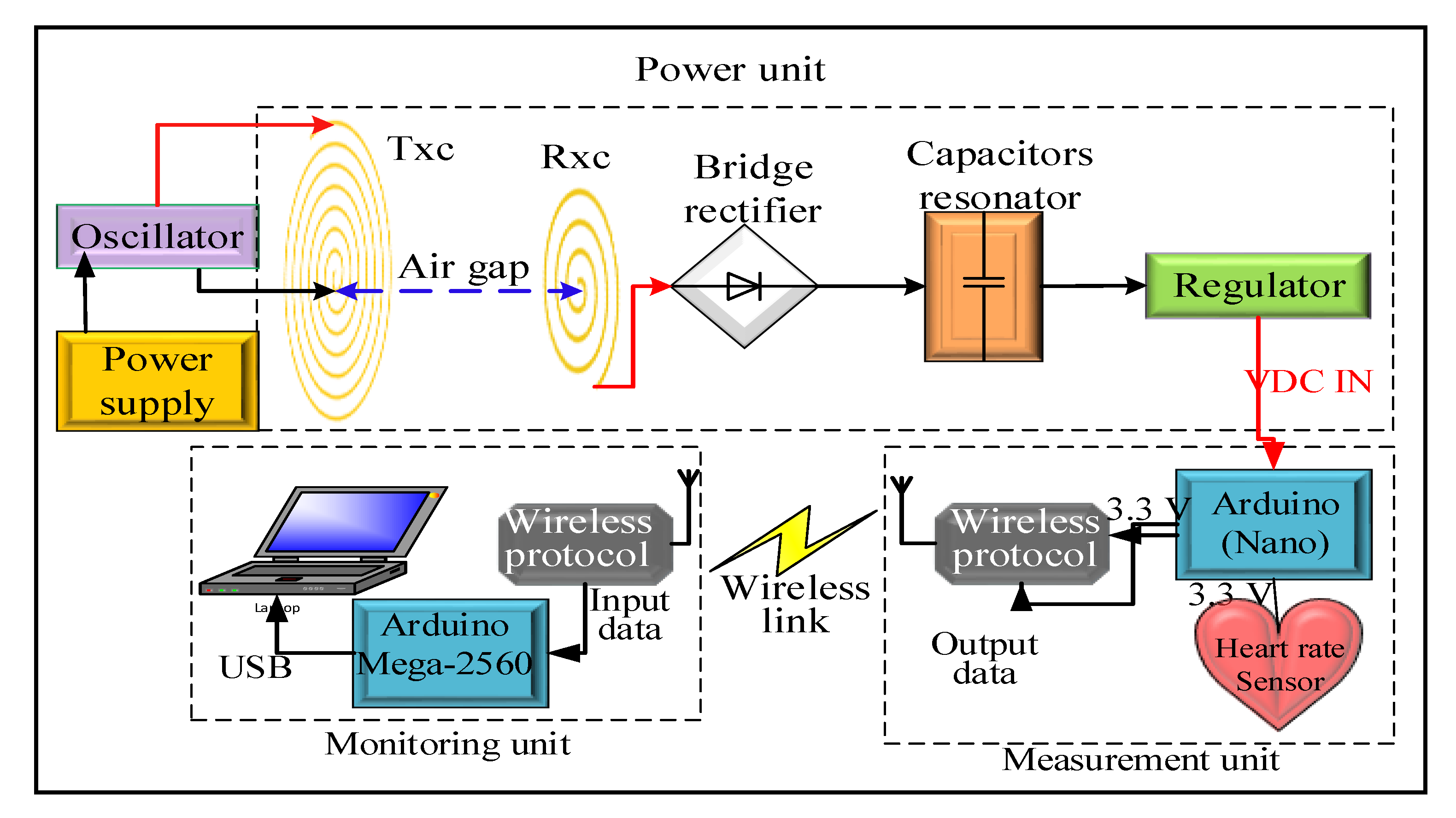

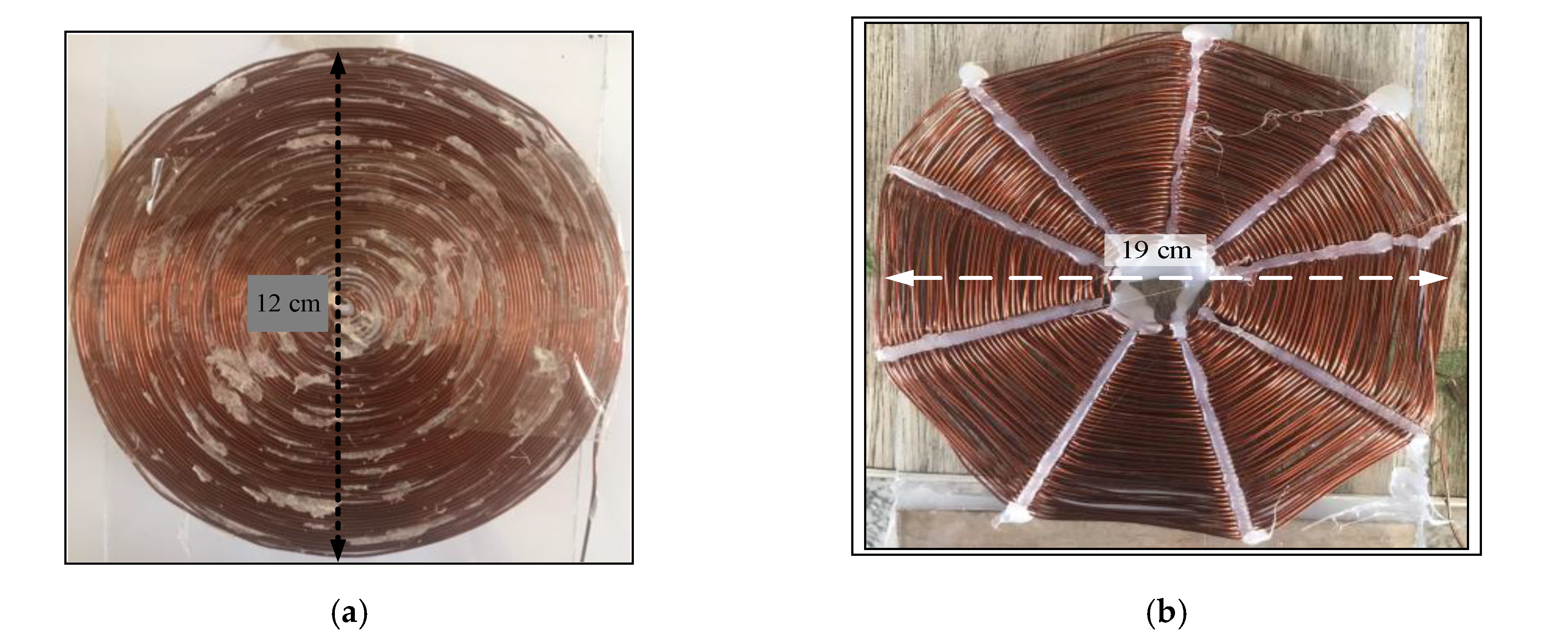
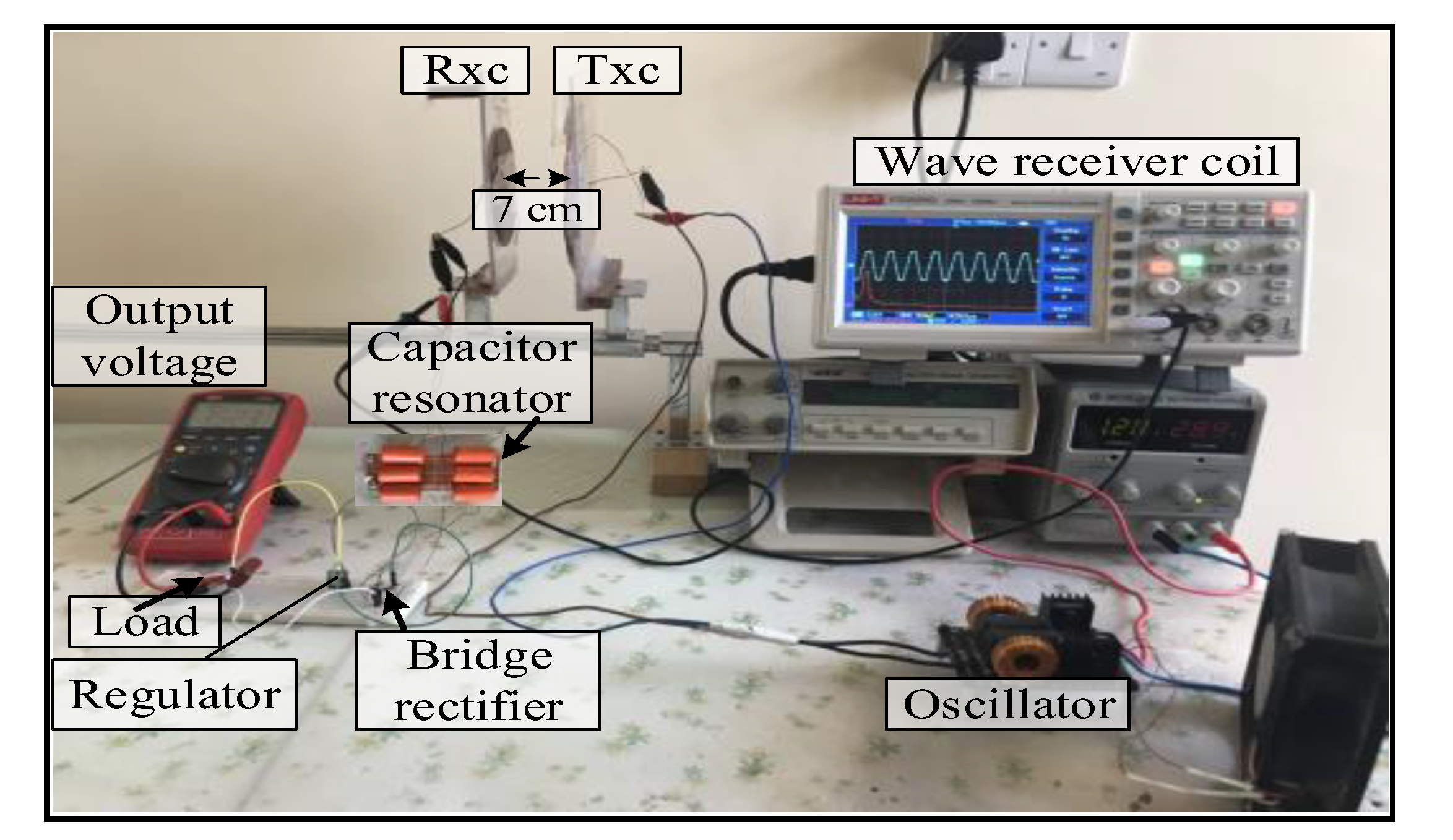
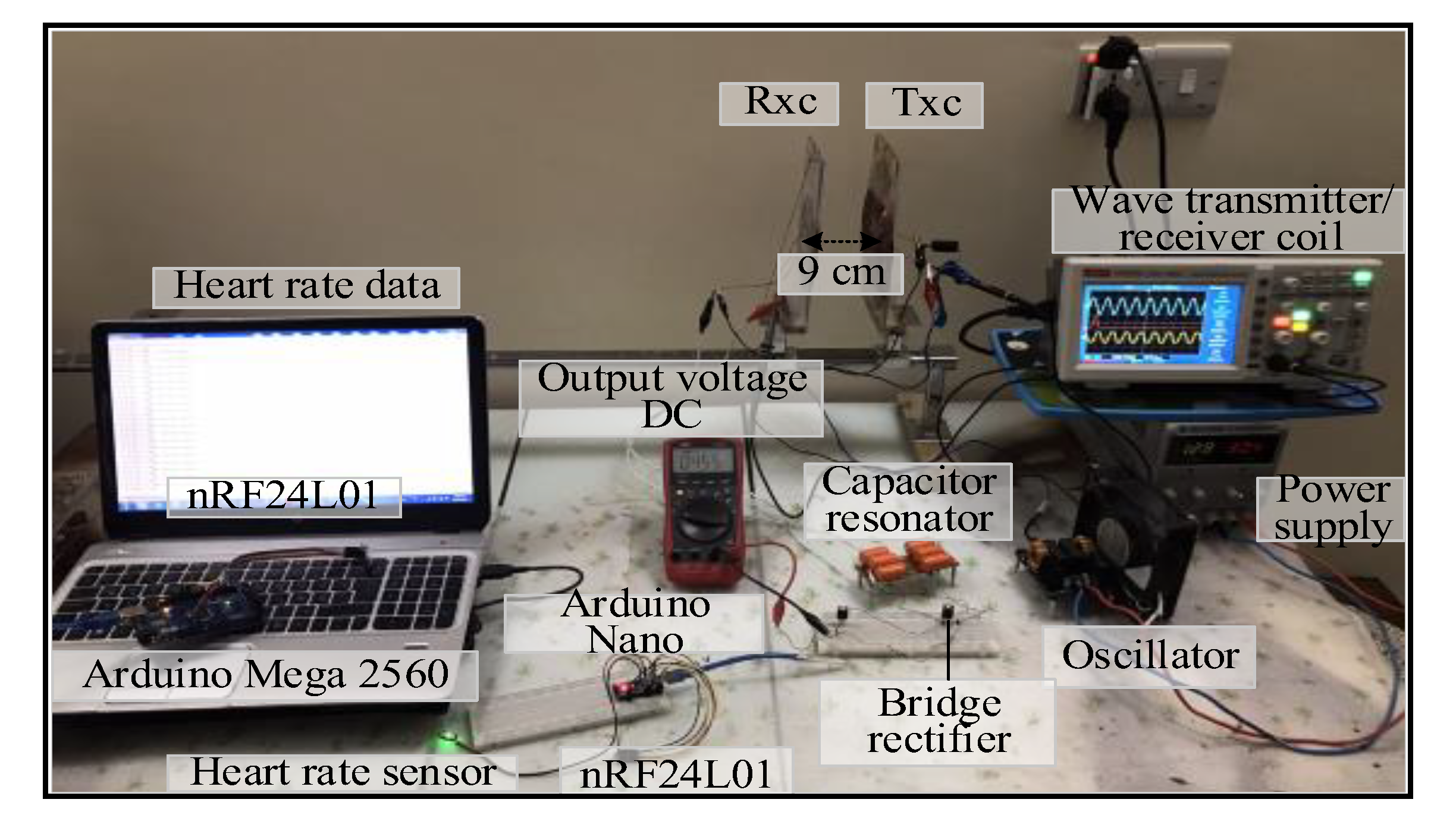
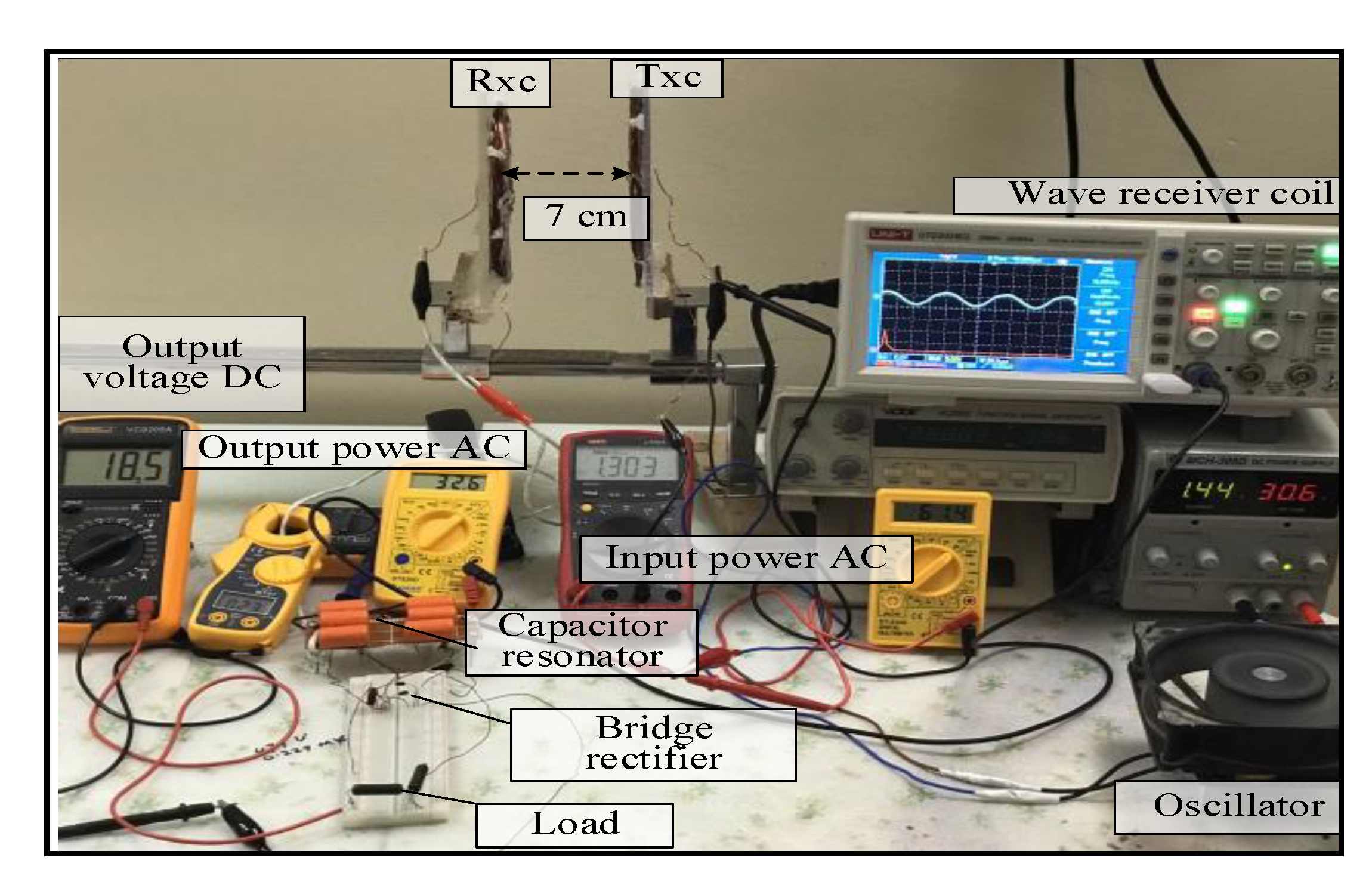
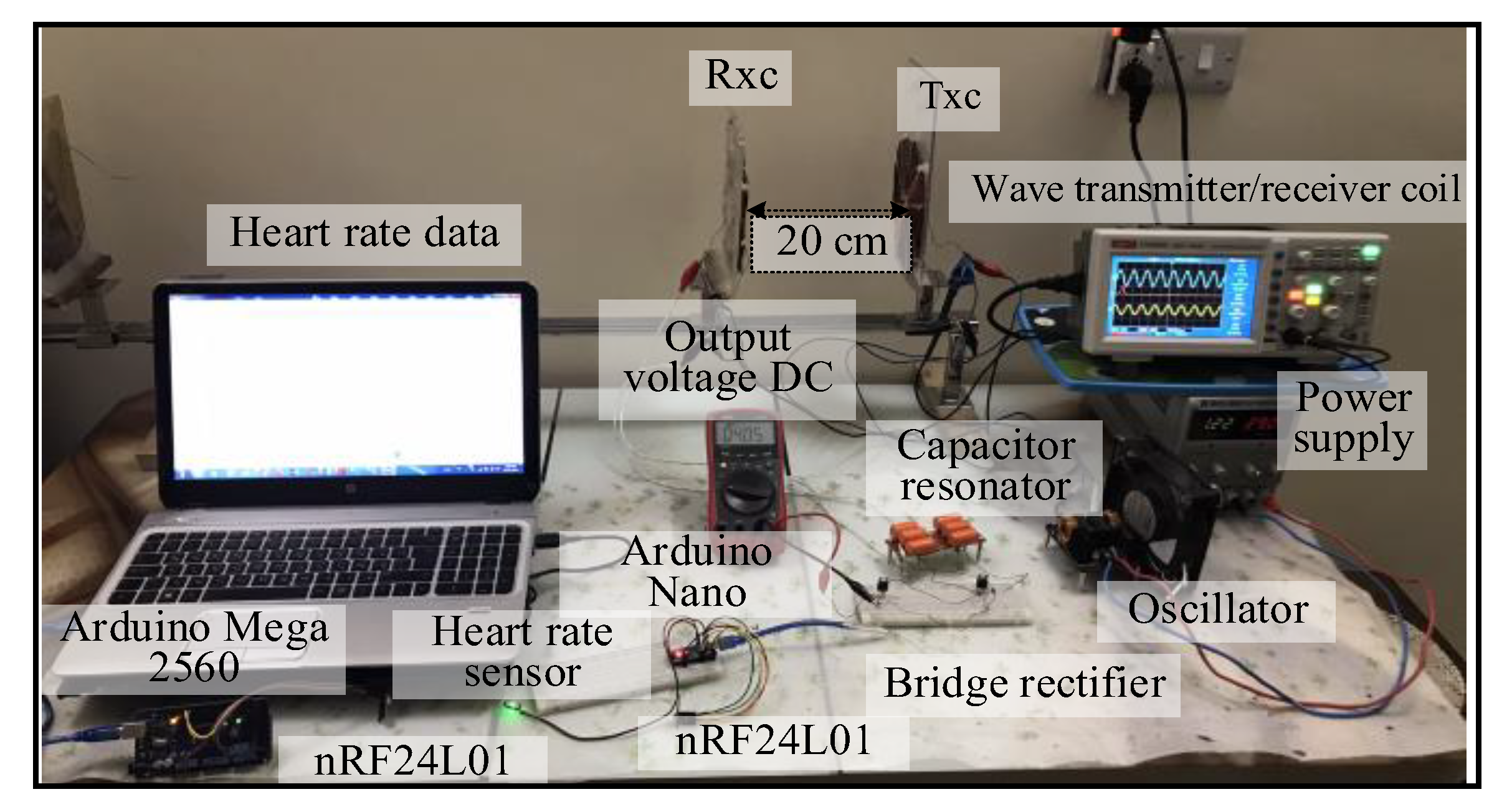
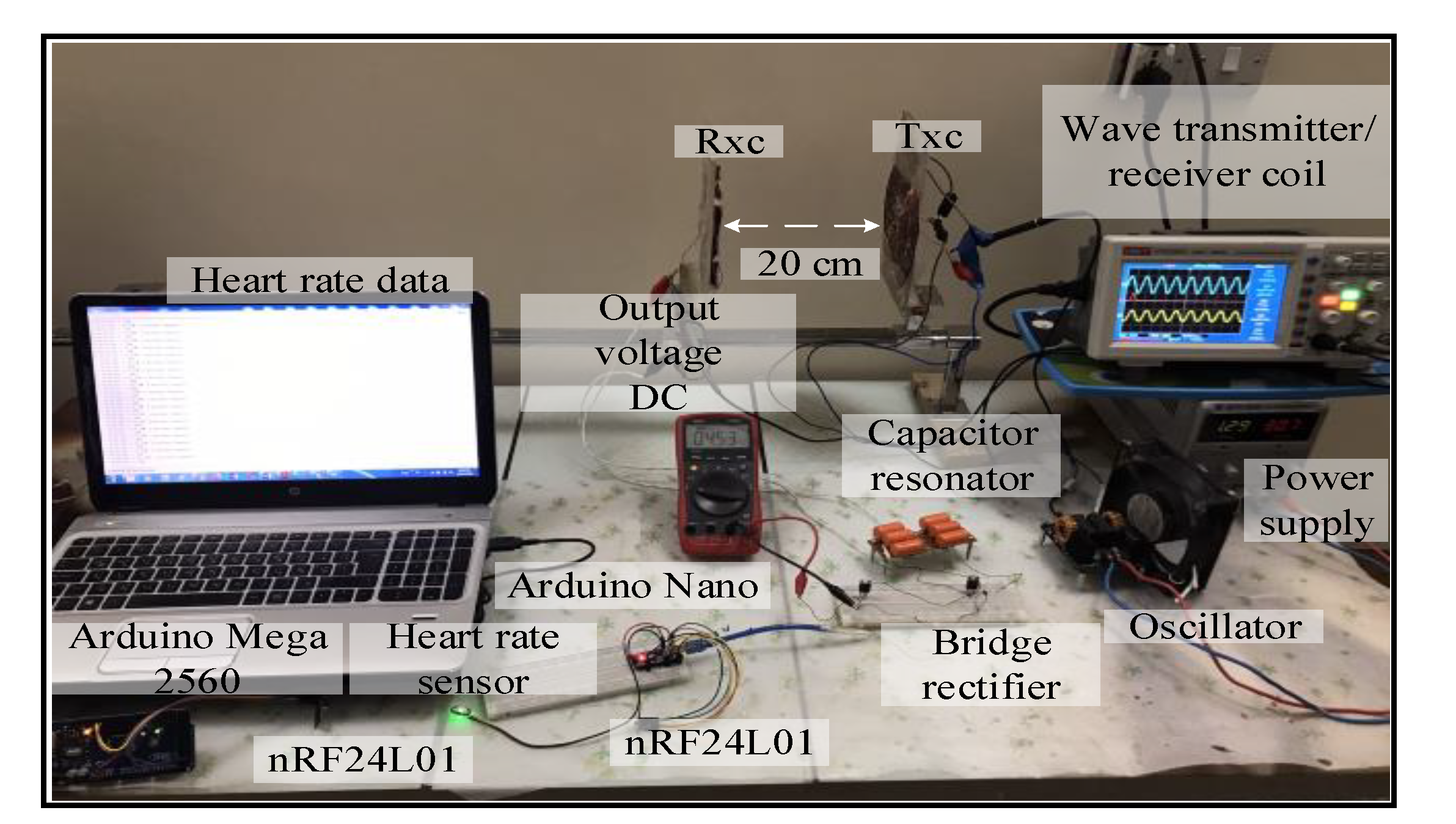
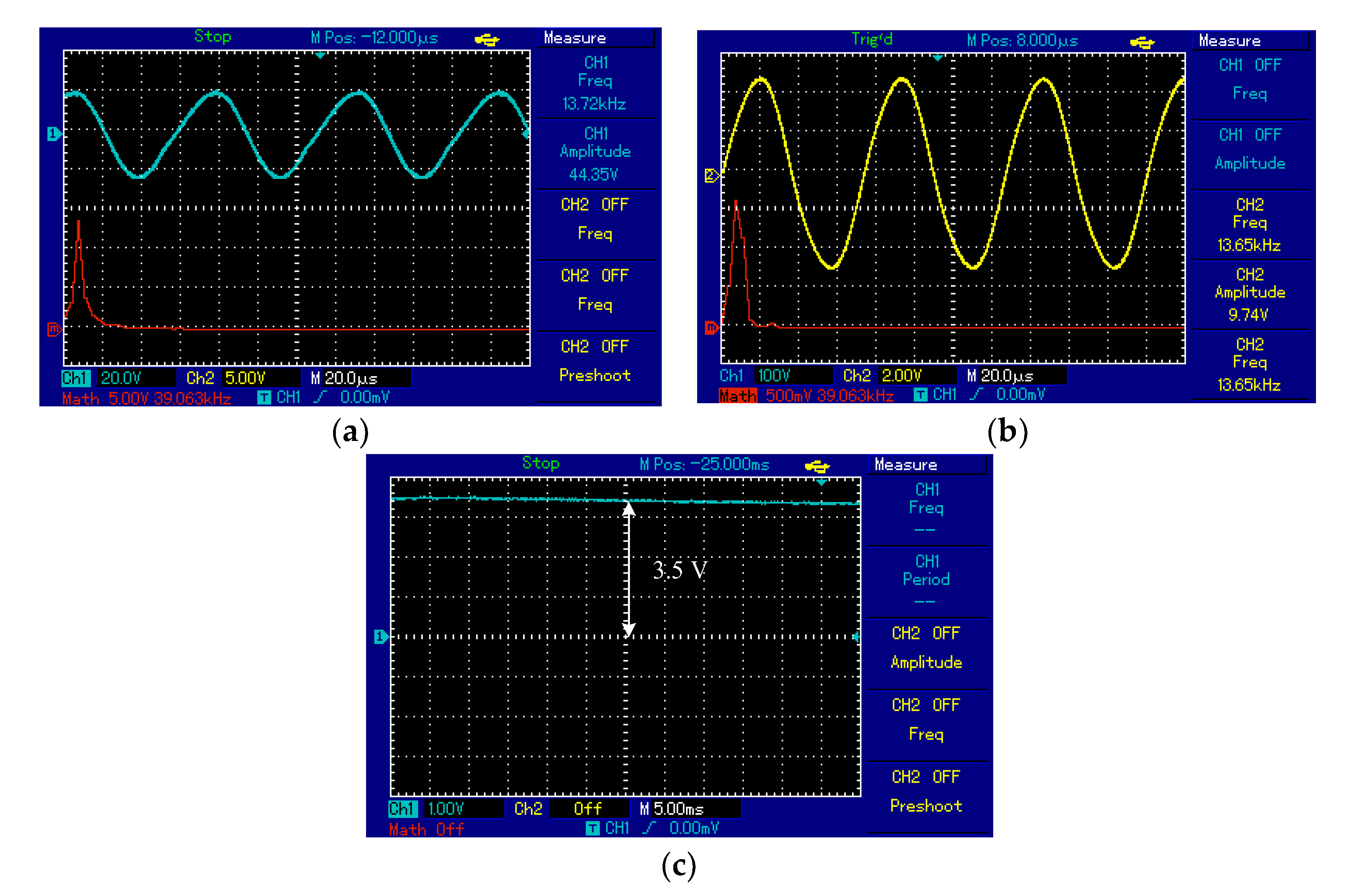

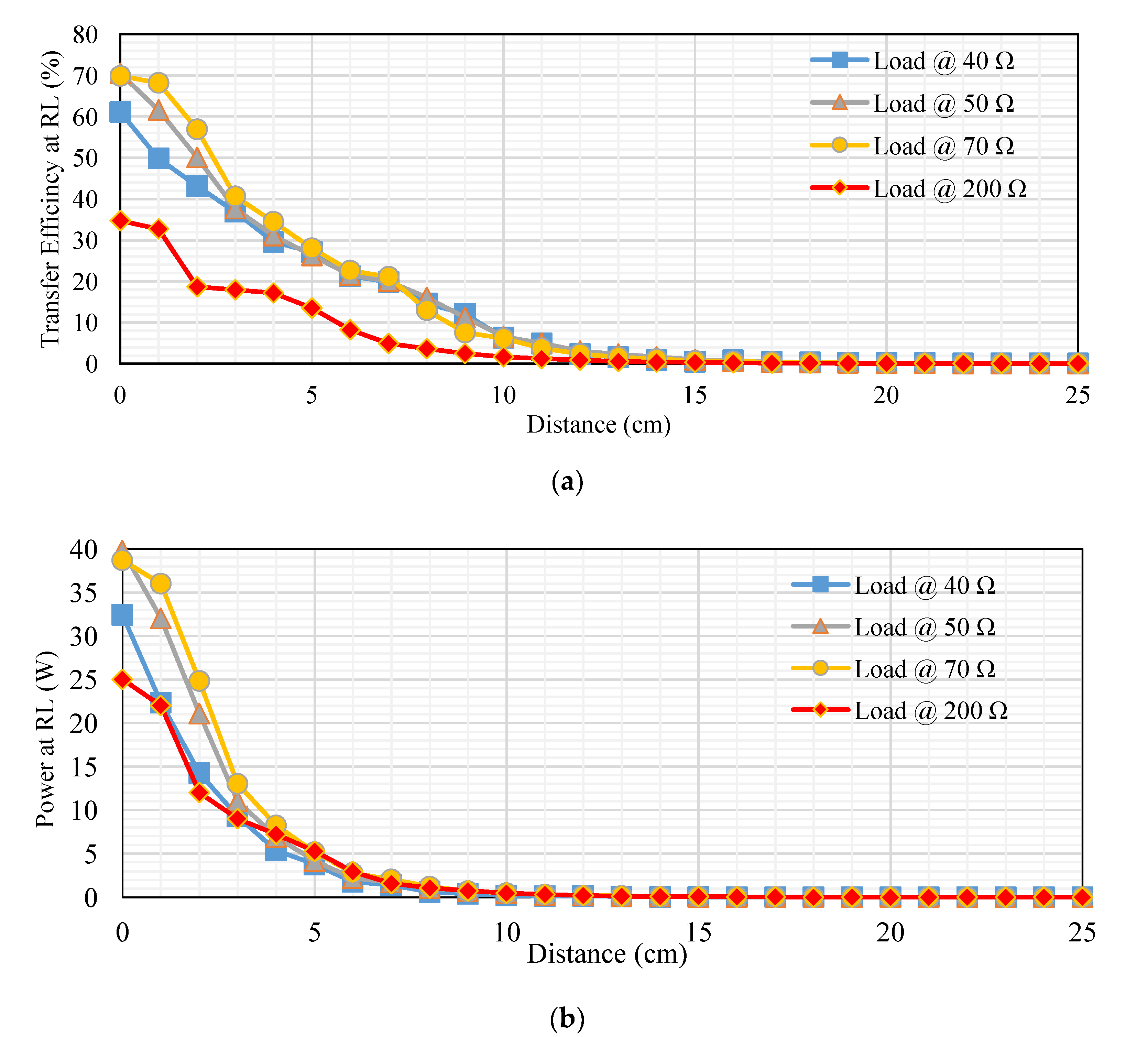



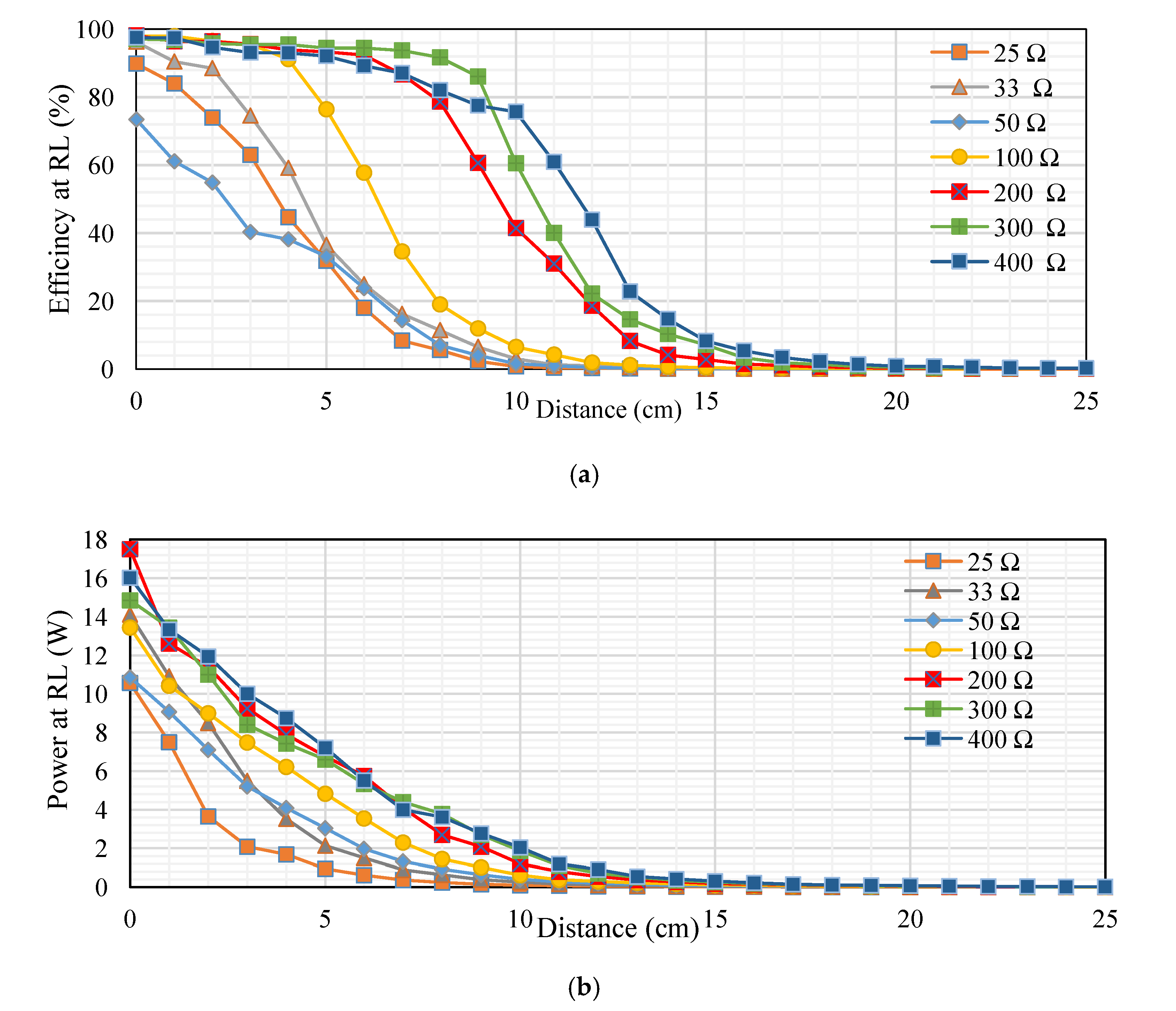
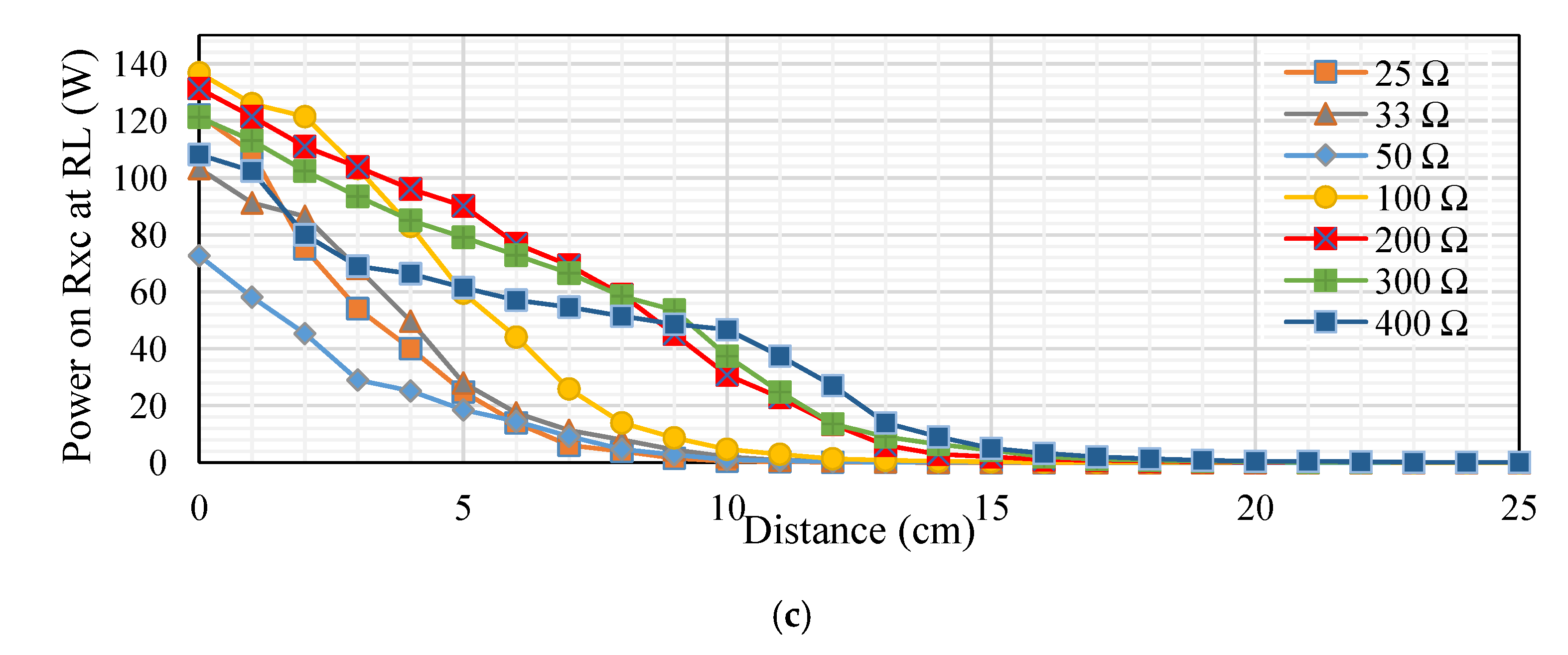


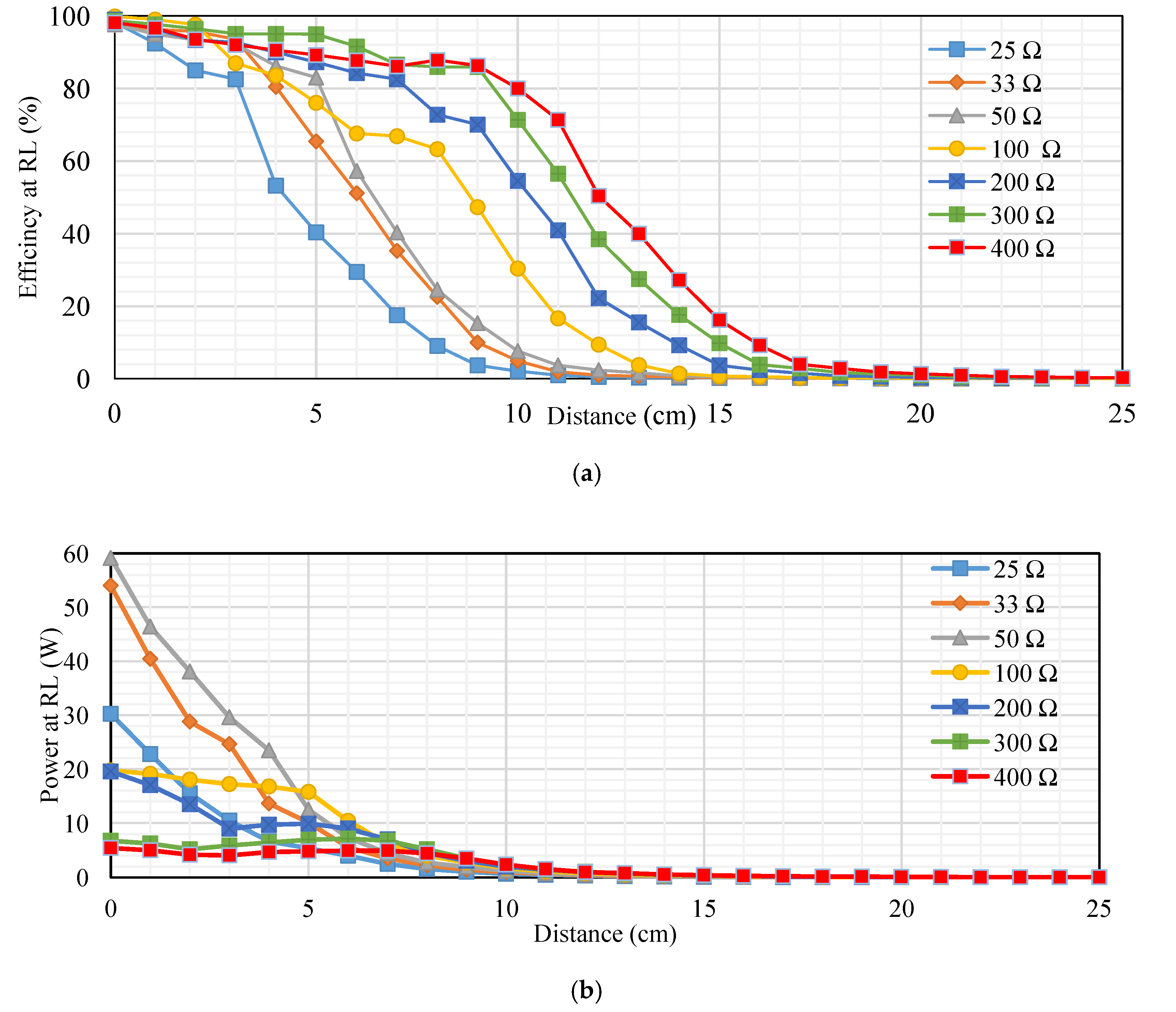
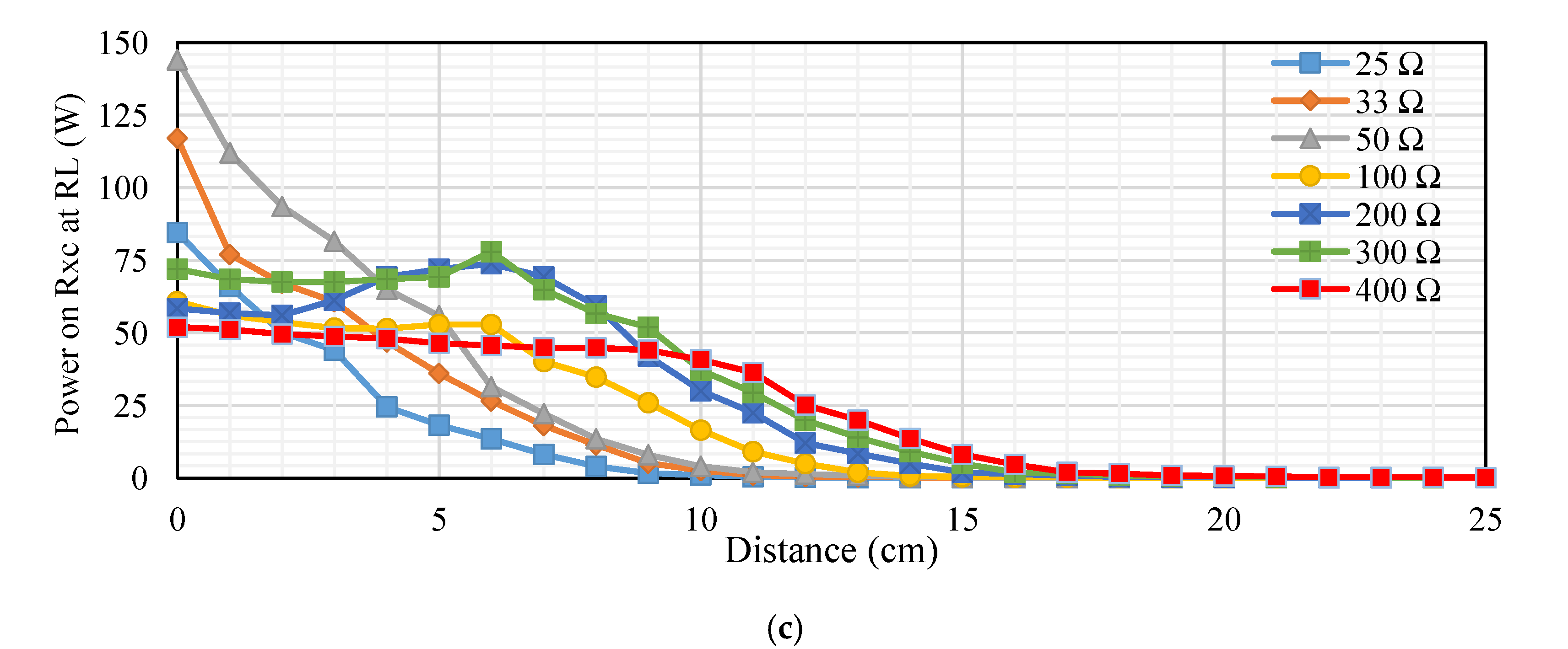
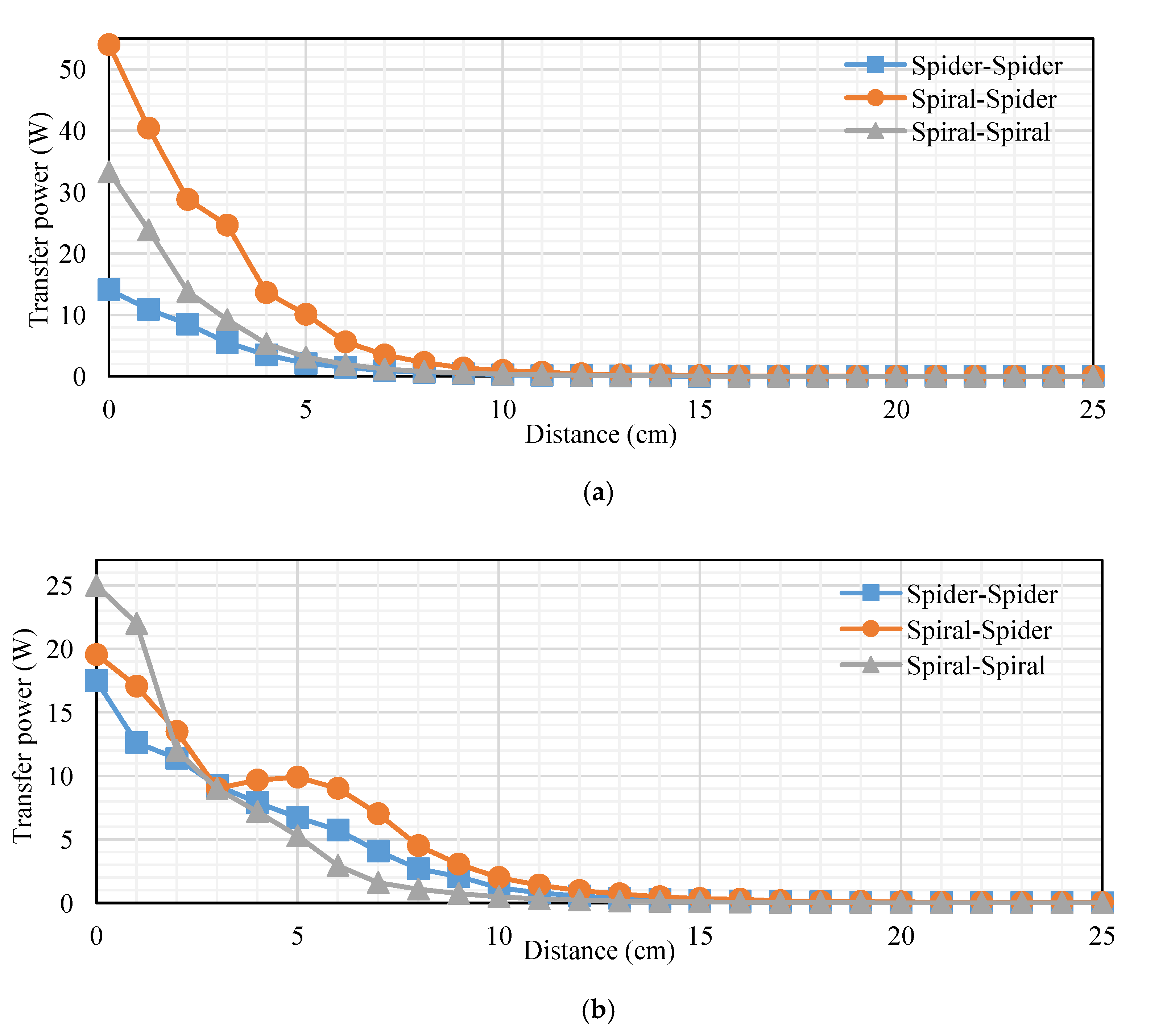
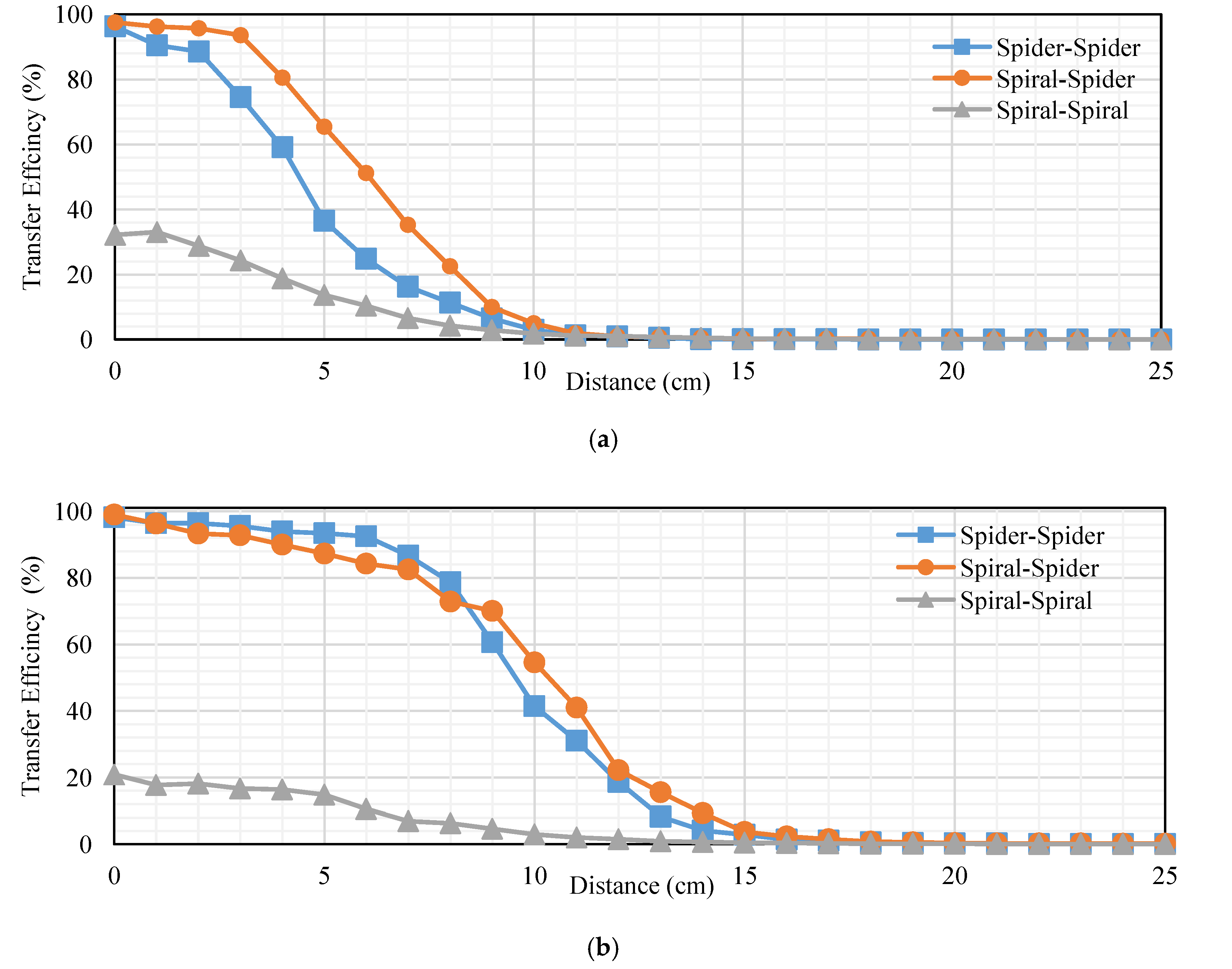

| Parameters | Unit | Value for Transmitter Coil | |
|---|---|---|---|
| Spiral | Spider | ||
| DC Input voltage | V | 30 | |
| AC out voltage | V | 19 | 28 |
| Operating frequency | kHz | 13.6 | 13.6 |
| American wire gage (AWG) | ---- | 21 | |
| Inductance | µH | 695 | 720 |
| Number of turns | turns | 91 | 150 |
| Diameter of turn | cm | 18 | 19 |
| Compensating capacitor | pF | 150 | |
| Parameters | Unit | Value for Receiver Coil | |
|---|---|---|---|
| Spiral | Spider | ||
| AC out voltage | V | Based on distance | |
| Operating frequency | kHz | 13.6 | |
| American wire gage (AWG) | ---- | 21 | 23 |
| Inductance | µH | 208 | 1000 |
| Number of turns | turns | 62 | 100 |
| Diameter of turn | cm | 12 | 15 |
| Compensating capacitor | pF | 150 | |
| Resistive Load | @ 40 Ω | @ 50 Ω | @ 70 Ω | ||||
|---|---|---|---|---|---|---|---|
| Distances (cm) | Power (W) | Efficiency (%) | Power (W) | Efficiency (%) | Power (W) | Efficiency (%) | |
| 0 | 32.4 | 61.15 | 39.82 | 70.5 | 38.683 | 69.87 | |
| 1 | 22.344 | 49.87 | 32.01 | 61.63 | 36.0144 | 68.21 | |
| 2 | 14.234 | 43.16 | 21.087 | 50.11 | 24.8374 | 56.94 | |
| 3 | 9.248 | 36.89 | 11.0026 | 37.63 | 13.025 | 40.66 | |
| 4 | 5.356 | 29.6 | 6.885 | 31.11 | 8.24 | 34.48 | |
| 5 | 4.169 | 27.1 | 4.173 | 26.26 | 5.136 | 28.01 | |
| 6 | 1.7958 | 21.28 | 2.226 | 21.53 | 2.782 | 22.59 | |
| 7 | 1.386 | 19.86 | 1.71 | 20.02 | 2.079 | 21.14 | |
| 8 | 0.759 | 14.6 | 1.05 | 16.11 | 1.2533 | 13.01 | |
| 9 | 0.5246 | 12.1 | 0.72 | 11.26 | 0.73112 | 7.59 | |
| 10 | 0.476 | 6.28 | 0.5 | 6.53 | 0.4913 | 6.14 | |
| 11 | 0.3 | 4.86 | 0.312 | 5.02 | 0.34435 | 3.7 | |
| 12 | 0.195 | 2.32 | 0.2079 | 3.09 | 0.22794 | 2.36 | |
| 13 | 0.1 | 1.55 | 0.156 | 2.31 | 0.16317 | 1.58 | |
| 14 | 0.0756 | 0.82 | 0.0968 | 1.61 | 0.1148 | 1.11 | |
| 15 | 0.0476 | 0.47 | 0.074 | 1.01 | 0.08365 | 0.73 | |
| 16 | 0.0348 | 0.76 | 0.0496 | 0.67 | 0.0615 | 0.53 | |
| 17 | 0.025 | 0.39 | 0.0378 | 0.5 | 0.04375 | 0.37 | |
| 18 | 0.0189 | 0.3 | 0.0242 | 0.31 | 0.03066 | 0.27 | |
| 19 | 0.01332 | 0.19 | 0.02 | 0.24 | 0.02413 | 0.2 | |
| 20 | 0.00945 | 0.14 | 0.0144 | 0.16 | 0.0176 | 0.14 | |
| 21 | 0.00702 | 0.1 | 0.0091 | 0.12 | 0.01209 | 0.1 | |
| 22 | 0.00506 | 0.07 | 0.0072 | 0.09 | 0.00984 | 0.08 | |
| 23 | 0.0036 | 0.05 | 0.00459 | 0.07 | 0.0072 | 0.06 | |
| 24 | 0.0028 | 0.04 | 0.00344 | 0.05 | 0.00567 | 0.04 | |
| 25 | 0.0021 | 0.03 | 0.0028 | 0.03 | 0.00378 | 0.03 | |
| RL | 25 Ω | 33 Ω | 50 Ω | 100 Ω | 200 Ω | 300 Ω | 400 Ω | ||||||||
|---|---|---|---|---|---|---|---|---|---|---|---|---|---|---|---|
| D (cm) | P (W) | ƞ (%) | P (W) | ƞ (%) | P(W) | ƞ (%) | P (W) | ƞ (%) | P (W) | ƞ (%) | P (W) | ƞ (%) | P (W) | ƞ (%) | |
| 0 | 10.56 | 89.88 | 14.1 | 96.27 | 10.85 | 73.48 | 13 | 97.96 | 17.5 | 98.16 | 14.85 | 97.12 | 16 | 97.5 | |
| 1 | 7.5 | 83.96 | 10.906 | 90.48 | 9.06 | 61.12 | 10 | 97.93 | 12.6 | 96.44 | 13.44 | 96.76 | 13 | 97.4 | |
| 2 | 3.653 | 73.9 | 8.494 | 88.52 | 7.1 | 54.84 | 9 | 96.55 | 11.4 | 96.37 | 11 | 95.83 | 12 | 94.7 | |
| 3 | 2.08 | 62.94 | 5.5 | 74.54 | 5.2 | 40.33 | 7.5 | 95.56 | 9.26 | 95.55 | 8.4 | 95.51 | 10 | 93.1 | |
| 4 | 1.68 | 44.64 | 3.52 | 59.14 | 4.08 | 38.18 | 6.2 | 91.21 | 7.9 | 93.95 | 7.426 | 95.45 | 8.7 | 93.1 | |
| 5 | 0.95 | 31.79 | 2.136 | 36.51 | 3.04 | 33.11 | 4.8 | 76.45 | 6.75 | 93.37 | 6.6 | 94.5 | 7.2 | 92.1 | |
| 6 | 0.616 | 17.95 | 1.5 | 24.89 | 1.963 | 23.76 | 3.6 | 57.74 | 5.74 | 92.41 | 5.332 | 94.48 | 5.5 | 89.2 | |
| 7 | 0.3565 | 8.33 | 0.88 | 16.24 | 1.32 | 14.36 | 2.3 | 34.57 | 4.08 | 86.63 | 4.4 | 93.73 | 4 | 87.1 | |
| 8 | 0.23 | 5.58 | 0.644 | 11.4 | 0.926 | 6.97 | 1.4 | 18.94 | 2.7 | 78.67 | 3.78 | 91.69 | 3.6 | 82.1 | |
| 9 | 0.15 | 2.23 | 0.375 | 6.48 | 0.64 | 4.06 | 1 | 11.89 | 2.08 | 60.62 | 2.7 | 86.01 | 2.8 | 77.5 | |
| 10 | 0.10168 | 0.7 | 0.248 | 3 | 0.4066 | 1.58 | 0.6 | 6.49 | 1.2 | 41.4 | 1.87 | 60.55 | 2 | 75.7 | |
| 11 | 0.07038 | 0.37 | 0.17085 | 1.28 | 0.2759 | 0.93 | 0.4 | 4.19 | 0.8 | 31 | 1.107 | 40.01 | 1.2 | 60.9 | |
| 12 | 0.04704 | 0.18 | 0.12056 | 0.9 | 0.2025 | 0.46 | 0.3 | 1.82 | 0.54 | 18.6 | 0.714 | 22.13 | 0.9 | 43.9 | |
| 13 | 0.036 | 0.11 | 0.08388 | 0.51 | 0.152 | 0.27 | 0.2 | 1.19 | 0.37 | 8.27 | 0.504 | 14.58 | 0.5 | 22.8 | |
| 14 | 0.0248 | 0.04 | 0.06 | 0.07 | 0.096 | 0.24 | 0.2 | 0.68 | 0.28 | 4.14 | 0.347 | 10.29 | 0.4 | 14.7 | |
| 15 | 0.0182 | 0.04 | 0.04368 | 0.06 | 0.07 | 0.21 | 0.1 | 0.43 | 0.19 | 2.82 | 0.252 | 7.14 | 0.3 | 8.24 | |
| 16 | 0.0132 | 0.03 | 0.03146 | 0.06 | 0.0516 | 0.09 | 0.1 | 0.26 | 0.15 | 1.46 | 0.189 | 3.25 | 0.2 | 5.39 | |
| 17 | 0.00969 | 0.03 | 0.02337 | 0.05 | 0.042 | 0.08 | 0.1 | 0.23 | 0.11 | 1.08 | 0.139 | 1.82 | 0.2 | 3.41 | |
| 18 | 0.00748 | 0.02 | 0.01785 | 0.04 | 0.0288 | 0.07 | 0.1 | 0.2 | 0.08 | 0.61 | 0.101 | 1.37 | 0.1 | 2.13 | |
| 19 | 0.006 | 0.02 | 0.0138 | 0.04 | 0.0224 | 0.06 | 0.1 | 0.09 | 0.07 | 0.42 | 0.081 | 0.78 | 0.1 | 1.39 | |
| 20 | 0.00442 | 0.02 | 0.0104 | 0.03 | 0.0168 | 0.05 | 0.1 | 0.07 | 0.05 | 0.25 | 0.06 | 0.54 | 0.1 | 0.82 | |
| 21 | 0.0033 | 0.02 | 0.0077 | 0.03 | 0.012 | 0.05 | 0.1 | 0.06 | 0.04 | 0.23 | 0.051 | 0.33 | 0.1 | 0.72 | |
| 22 | 0.0026 | 0.01 | 0.006 | 0.03 | 0.0086 | 0.04 | 0.1 | 0.06 | 0.03 | 0.1 | 0.04 | 0.28 | 0.1 | 0.49 | |
| 23 | 0.00207 | 0.01 | 0.00486 | 0.02 | 0.008 | 0.04 | 0.1 | 0.05 | 0.02 | 0.08 | 0.028 | 0.24 | 0.1 | 0.29 | |
| 24 | 0.00168 | 0.01 | 0.004 | 0.02 | 0.0068 | 0.03 | 0.1 | 0.05 | 0.02 | 0.08 | 0.022 | 0.23 | 0.1 | 0.26 | |
| 25 | 0.00133 | 0.01 | 0.00294 | 0.02 | 0.0056 | 0.03 | 0.1 | 0.04 | 0.01 | 0.07 | 0.018 | 0.2 | 0.1 | 0.23 | |
| RL | 25 Ω | 33 Ω | 50 Ω | 100 Ω | 200 Ω | 300 Ω | 400 Ω | ||||||||
|---|---|---|---|---|---|---|---|---|---|---|---|---|---|---|---|
| D (cm) | P (W) | ƞ (%) | P (W) | ƞ (%) | P (W) | ƞ (%) | P (W) | ƞ (%) | P (W) | ƞ (%) | P (W) | ƞ (%) | P (W) | ƞ (%) | |
| 0 | 30.24 | 98.26 | 54 | 97.5 | 59.16 | 97.63 | 19.78 | 99.84 | 19.56 | 98.98 | 6.768 | 98.63 | 5.445 | 98.11 | |
| 1 | 22.814 | 92.44 | 40.4 | 96.25 | 46.41 | 94.92 | 19.125 | 99.03 | 17.05 | 96.27 | 6.3 | 97.71 | 5.04 | 96.6 | |
| 2 | 15.5 | 85.03 | 28.8 | 95.71 | 38.07 | 93.32 | 18.06 | 97.6 | 13.5 | 93.33 | 5.2 | 96.43 | 4.18 | 93.58 | |
| 3 | 10.44 | 82.55 | 24.64 | 93.54 | 29.6 | 92.2 | 17.22 | 86.94 | 9.03 | 92.73 | 5.88 | 95.07 | 4.1 | 92.08 | |
| 4 | 6.656 | 53.26 | 13.65 | 80.48 | 23.45 | 86.21 | 16.8 | 83.57 | 9.68 | 90 | 6.45 | 95 | 4.73 | 90.57 | |
| 5 | 5.4 | 40.33 | 10.08 | 65.45 | 12.5 | 83.04 | 15.8 | 76.05 | 9.9 | 87.27 | 6.975 | 94.93 | 4.84 | 89.23 | |
| 6 | 4 | 29.41 | 5.6 | 51.15 | 7.372 | 57.27 | 10.4 | 67.6 | 9.03 | 84.25 | 7.2 | 91.55 | 4.95 | 87.69 | |
| 7 | 2.48 | 17.54 | 3.52 | 35.29 | 4.47 | 40.36 | 6.25 | 66.87 | 7.03 | 82.5 | 6.776 | 86.63 | 4.95 | 86.15 | |
| 8 | 1.5325 | 9.07 | 2.25 | 22.55 | 2.76 | 24.55 | 4 | 63.27 | 4.5 | 72.79 | 5.2 | 85.91 | 4.452 | 87.84 | |
| 9 | 1.05 | 3.73 | 1.4 | 10 | 1.95 | 15.38 | 2.72 | 47.27 | 3.05 | 70 | 3.52 | 85.95 | 3.534 | 86.27 | |
| 10 | 0.672 | 2.13 | 0.96 | 4.94 | 1.2 | 7.67 | 1.742 | 30.37 | 2 | 54.55 | 2.34 | 71.35 | 2.387 | 80 | |
| 11 | 0.455 | 1 | 0.65 | 1.88 | 0.78 | 3.69 | 1.1 | 16.67 | 1.394 | 40.91 | 1.47 | 56.54 | 1.575 | 71.37 | |
| 12 | 0.345 | 0.53 | 0.44 | 0.98 | 0.55 | 2.42 | 0.81 | 9.43 | 0.98 | 22.22 | 1.02 | 38.46 | 1 | 50.4 | |
| 13 | 0.198 | 0.28 | 0.27 | 0.71 | 0.396 | 1.62 | 0.518 | 3.77 | 0.72 | 15.56 | 0.75 | 27.45 | 0.792 | 40 | |
| 14 | 0.15 | 0.27 | 0.225 | 0.47 | 0.2775 | 0.77 | 0.378 | 1.42 | 0.5 | 9.26 | 0.48 | 17.65 | 0.54 | 27.2 | |
| 15 | 0.0915 | 0.22 | 0.128 | 0.24 | 0.189 | 0.52 | 0.26 | 0.68 | 0.336 | 3.7 | 0.385 | 9.8 | 0.416 | 16.2 | |
| 16 | 0.068 | 0.18 | 0.0972 | 0.2 | 0.1378 | 0.27 | 0.225 | 0.57 | 0.28 | 2.37 | 0.31 | 3.92 | 0.297 | 9.2 | |
| 17 | 0.0495 | 0.18 | 0.0675 | 0.17 | 0.099 | 0.23 | 0.156 | 0.34 | 0.186 | 1.56 | 0.216 | 2.82 | 0.24 | 4 | |
| 18 | 0.04 | 0.13 | 0.052 | 0.16 | 0.0741 | 0.19 | 0.096 | 0.26 | 0.13 | 0.81 | 0.161 | 1.76 | 0.168 | 2.88 | |
| 19 | 0.0297 | 0.06 | 0.0408 | 0.13 | 0.0544 | 0.08 | 0.0784 | 0.25 | 0.1058 | 0.56 | 0.126 | 1.27 | 0.126 | 1.8 | |
| 20 | 0.025 | 0.05 | 0.03 | 0.12 | 0.042 | 0.07 | 0.0625 | 0.11 | 0.08 | 0.33 | 0.09 | 0.94 | 0.096 | 1.3 | |
| 21 | 0.021 | 0.05 | 0.0221 | 0.11 | 0.0312 | 0.07 | 0.0484 | 0.09 | 0.0648 | 0.3 | 0.0675 | 0.59 | 0.077 | 0.96 | |
| 22 | 0.0132 | 0.04 | 0.01679 | 0.05 | 0.0253 | 0.06 | 0.0361 | 0.08 | 0.048 | 0.26 | 0.056 | 0.53 | 0.06 | 0.6 | |
| 23 | 0.009 | 0.04 | 0.013 | 0.04 | 0.02 | 0.05 | 0.0272 | 0.08 | 0.0392 | 0.23 | 0.042 | 0.31 | 0.0495 | 0.54 | |
| 24 | 0.007 | 0.04 | 0.01026 | 0.04 | 0.0162 | 0.05 | 0.0225 | 0.07 | 0.0288 | 0.21 | 0.0352 | 0.27 | 0.04 | 0.32 | |
| 25 | 0.005 | 0.03 | 0.00816 | 0.04 | 0.0112 | 0.04 | 0.0182 | 0.06 | 0.0242 | 0.19 | 0.028 | 0.24 | 0.0315 | 0.28 | |
| Ref/Year | Objective | Operating Frequency (MHz) | Implementation Environment | Application | Transfer Distance (cm) | Transfer Efficiency (%) | Transfer Power (W) |
|---|---|---|---|---|---|---|---|
| [12]/2009 | OTE | 7 | Experimental | Id | 9 | 22.3 | N/A |
| [8]/2010 | OTE | 0.7 | Experimental | Id | 0.32 | 72 | N/A |
| [11]/2011 | OTE | 0.00988 | Simulation by using Proteus | LVAD | N/A | N/A | 1.5 |
| [7]/2013 | OTE | 0.9532 | Experimental | light neon, and lamp | 1–15 | N/A | N/A |
| [9]/2014 | OTE | 2.75 | Experimental | Prototype | 3 | 93.1 | N/A |
| [10]/2014 | OTE | 16.47 | Experimental | capsule endoscopy | 7 | 0.71 | N/A |
| [14]/2014 | OTDE | 0.3 | Experimental | implantable cardioverter defibrillators | 6 | 7 | 1 |
| [13]/2015 | OTDE | 403 | Experimental | pacemaker | 10 | 5.24 | 10 × 10−6 1 × 10−3 |
| [15]/2016 | battery-recharge | 0.3–13.56 | Experimental | pacemaker | 10 | N/A | 0.0004 |
| [17]/2016 | OTDE | 0.02 | Simulation by multiphysics COMSOL | pacemaker | 41 | N/A | N/A |
| [18]/2016 | OTE | 137 | Experimental | Brain region | 2.8 | 0.76 @air 0.6@ lamb head | 240 × 10−6 191 × 10−6 |
| [19]/2018 | OTDE | 1 | Experimental | home appliance operations | 2 6 | 80.66 66.66 | 4.84 4 |
| Spiral–spiral topology | OTDE | 0.014 | Experimental | Heart rate sensor | 5 8 10 | 28.8 13 6.4 | 5 1.3 0.5 |
| Spider- spidertopology | OTDE | 0.014 | Experimental | Heart rate sensor | 5 8 10 | 92.11 82.02 75.8 | 7.2 3.6 2.04 |
| Spiral–spider topology | OTDE | 0.014 | Experimental | Heart rate sensor | 5 8 10 | 90 88 80 | 5 4.5 2.5 |
© 2020 by the authors. Licensee MDPI, Basel, Switzerland. This article is an open access article distributed under the terms and conditions of the Creative Commons Attribution (CC BY) license (http://creativecommons.org/licenses/by/4.0/).
Share and Cite
Mahmood, M.F.; Mohammed, S.L.; Gharghan, S.K.; Al-Naji, A.; Chahl, J. Hybrid Coils-Based Wireless Power Transfer for Intelligent Sensors. Sensors 2020, 20, 2549. https://doi.org/10.3390/s20092549
Mahmood MF, Mohammed SL, Gharghan SK, Al-Naji A, Chahl J. Hybrid Coils-Based Wireless Power Transfer for Intelligent Sensors. Sensors. 2020; 20(9):2549. https://doi.org/10.3390/s20092549
Chicago/Turabian StyleMahmood, Mustafa F., Saleem Lateef Mohammed, Sadik Kamel Gharghan, Ali Al-Naji, and Javaan Chahl. 2020. "Hybrid Coils-Based Wireless Power Transfer for Intelligent Sensors" Sensors 20, no. 9: 2549. https://doi.org/10.3390/s20092549
APA StyleMahmood, M. F., Mohammed, S. L., Gharghan, S. K., Al-Naji, A., & Chahl, J. (2020). Hybrid Coils-Based Wireless Power Transfer for Intelligent Sensors. Sensors, 20(9), 2549. https://doi.org/10.3390/s20092549







